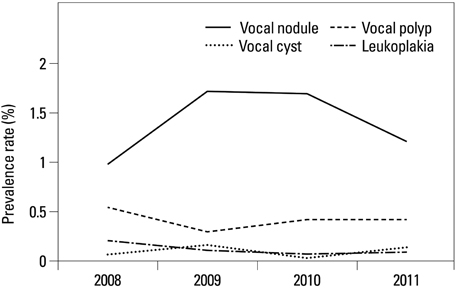Yonsei Med J.
2014 Mar;55(2):499-507.
Prevalence of Laryngeal Disease in South Korea: Data from the Korea National Health and Nutrition Examination Survey from 2008 to 2011
- Affiliations
-
- 1Department of Otolaryngology, Gyeongsang National University, Jinju, Korea. lesaby@hanmail.net
- 2Institute of Health Sciences, Gyeongsang National University, Jinju, Korea.
- 3Dong-A University Hospital Regional Cardiocerebrovascular Center, Busan, Korea.
- 4Department of Otolaryngology, Asan Medical Center, University of Ulsan College of Medicine, Seoul, Korea.
- 5Department of Otolaryngology-Head and Neck Surgery, Soonchunhyang University College of Medicine, Bucheon, Korea.
Abstract
- PURPOSE
The aim of this study was to evaluate the prevalence of Benign Vocal Fold Lesion (polyp, cysts, nodules) and Leukoplakia in Korea.
MATERIALS AND METHODS
The data from the 2008 to 2011 Korea National Health and Nutrition Examination Surveys, which were cross-sectional survey of the civilian noninstitutionalized population of South Korea. A survey team that included an otolaryngology residents, nurses, and interviewers moved with a mobile examination unit and performed laryngologic interviews and examinations of vocal folds using rigid telescopic laryngoscopy on survey participants over 19 years old (n=19636).
RESULTS
Laryngoscopic examination revealed normal results in 19251 (98.04%) of those included in the survey. Abnormal laryngoscopic findings were observed in 1.96% of the population examined, and vocal cord nodules were the most common abnormal finding. The prevalence of vocal cord nodules was 0.99-1.72%, the prevalence of vocal cord polyps was 0.31-0.55%, the prevalence of vocal cysts was 0.04-0.17%, and the prevalence of vocal cord leukoplakia was 0.07-0.21%. There was no significant correlation of linear trend of prevalence by year, and there were no significant differences in prevalence between males and females.
CONCLUSION
This is the first nationwide epidemiologic study to assess the prevalence of Benign Vocal Fold Lesion (polyp, cysts, nodules) and Leukoplakia by both the Korean Otolaryngologic Society and the Ministry of Health and Welfare. The results of this large epidemiologic study provide valuable information regarding the prevalence of voice disorders and the management of laryngologic diseases.
Keyword
MeSH Terms
Figure
Reference
-
1. Cho YS, Choi SH, Park KH, Park HJ, Kim JW, Moon IJ, et al. Prevalence of otolaryngologic diseases in South Korea: data from the Korea national health and nutrition examination survey 2008. Clin Exp Otorhinolaryngol. 2010; 3:183–193.
Article2. Agrawal Y, Platz EA, Niparko JK. Prevalence of hearing loss and differences by demographic characteristics among US adults: data from the National Health and Nutrition Examination Survey, 1999-2004. Arch Intern Med. 2008; 168:1522–1530.
Article3. Roy N, Merrill RM, Gray SD, Smith EM. Voice disorders in the general population: prevalence, risk factors, and occupational impact. Laryngoscope. 2005; 115:1988–1995.
Article4. Laguaite JK. Adult voice screening. J Speech Hear Disord. 1972; 37:147–151.
Article5. Morley DE. A ten-year survey of speech disorders among university students. J Speech Disord. 1952; 17:25–31.
Article6. Smith E, Lemke J, Taylor M, Kirchner HL, Hoffman H. Frequency of voice problems among teachers and other occupations. J Voice. 1998; 12:480–488.
Article7. Akif Kiliç M, Okur E, Yildirim I, Güzelsoy S. The prevalence of vocal fold nodules in school age children. Int J Pediatr Otorhinolaryngol. 2004; 68:409–412.
Article8. Angelillo N, Di Costanzo B, Angelillo M, Costa G, Barillari MR, Barillari U. Epidemiological study on vocal disorders in paediatric age. J Prev Med Hyg. 2008; 49:1–5.9. Duff MC, Proctor A, Yairi E. Prevalence of voice disorders in African American and European American preschoolers. J Voice. 2004; 18:348–353.
Article10. Powell M, Filter MD, Williams B. A longitudinal study of the prevalence of voice disorders in children from a rural school division. J Commun Disord. 1989; 22:375–382.
Article11. Roy N, Stemple J, Merrill RM, Thomas L. Epidemiology of voice disorders in the elderly: preliminary findings. Laryngoscope. 2007; 117:628–633.
Article12. Jones K, Sigmon J, Hock L, Nelson E, Sullivan M, Ogren F. Prevalence and risk factors for voice problems among telemarketers. Arch Otolaryngol Head Neck Surg. 2002; 128:571–577.
Article13. Roy N, Merrill RM, Thibeault S, Parsa RA, Gray SD, Smith EM. Prevalence of voice disorders in teachers and the general population. J Speech Lang Hear Res. 2004; 47:281–293.
Article14. Sliwinska-Kowalska M, Niebudek-Bogusz E, Fiszer M, Los-Spychalska T, Kotylo P, Sznurowska-Przygocka B, et al. The prevalence and risk factors for occupational voice disorders in teachers. Folia Phoniatr Logop. 2006; 58:85–101.
Article15. Gottliebson RO, Lee L, Weinrich B, Sanders J. Voice problems of future speech-language pathologists. J Voice. 2007; 21:699–704.
Article16. Van Houtte E, Van Lierde K, D'Haeseleer E, Claeys S. The prevalence of laryngeal pathology in a treatment-seeking population with dysphonia. Laryngoscope. 2010; 120:306–312.
Article17. Smith E, Kirchner HL, Taylor M, Hoffman H, Lemke JH. Voice problems among teachers: differences by gender and teaching characteristics. J Voice. 1998; 12:328–334.
Article18. Ward PD, Thibeault SL, Gray SD. Hyaluronic acid: its role in voice. J Voice. 2002; 16:303–309.19. Woo SH, Jeong HS, Kim JP, Koh EH, Lee SU, Jin SM, et al. Favorable vocal fold wound healing induced by platelet-rich plasma injection. Clin Exp Otorhinolaryngol. 2014; 7:47–52.
Article
- Full Text Links
- Actions
-
Cited
- CITED
-
- Close
- Share
- Similar articles
-
- Prevalence of Osteoporosis in the Korean Population Based on Korea National Health and Nutrition Examination Survey (KNHANES), 2008-2011
- The Korea National Health and Nutrition Examination Survey data linked Cause of Death data
- The Current Status and the Perspectives of Nutrition Survey
- Comparison of estimates and time series stability of Korea Community Health Survey and Korea National Health and Nutrition Examination Survey
- An Epidemiologic Survey of Strabismus and Nystagmus in South Korea: KNHANES V


